ASRock X99 WS-E/10G Motherboard Review: Dual 10GBase-T for Prosumers
by Ian Cutress on December 15, 2014 10:00 AM EST- Posted in
- Motherboards
- IT Computing
- Intel
- ASRock
- Enterprise
- X99
- 10GBase-T
CPU Performance
Readers of our motherboard review section will have noted the trend in modern motherboards to implement a form of MultiCore Enhancement / Acceleration / Turbo (read our report here) on their motherboards. This does several things, including better benchmark results at stock settings (not entirely needed if overclocking is an end-user goal) at the expense of heat and temperature. It also gives in essence an automatic overclock which may be against what the user wants. Our testing methodology is ‘out-of-the-box’, with the latest public BIOS installed and XMP enabled, and thus subject to the whims of this feature. It is ultimately up to the motherboard manufacturer to take this risk – and manufacturers taking risks in the setup is something they do on every product (think C-state settings, USB priority, DPC Latency / monitoring priority, memory subtimings at JEDEC). Processor speed change is part of that risk, and ultimately if no overclocking is planned, some motherboards will affect how fast that shiny new processor goes and can be an important factor in the system build.
For reference, the ASRock X99 WS-E/10G has MultiCore Turbo enabled by default on BIOS 1.01A.
Point Calculations – 3D Movement Algorithm Test: link
3DPM is a self-penned benchmark, taking basic 3D movement algorithms used in Brownian Motion simulations and testing them for speed. High floating point performance, MHz and IPC wins in the single thread version, whereas the multithread version has to handle the threads and loves more cores.
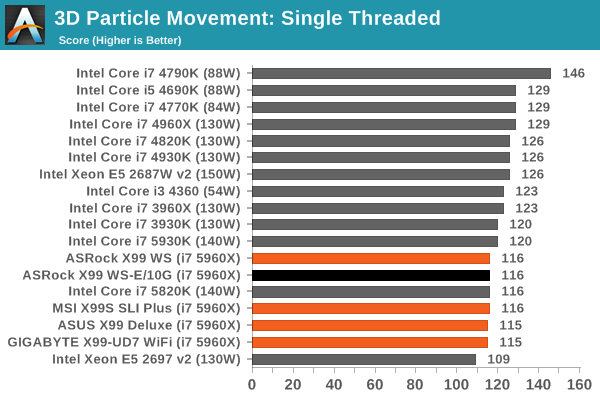
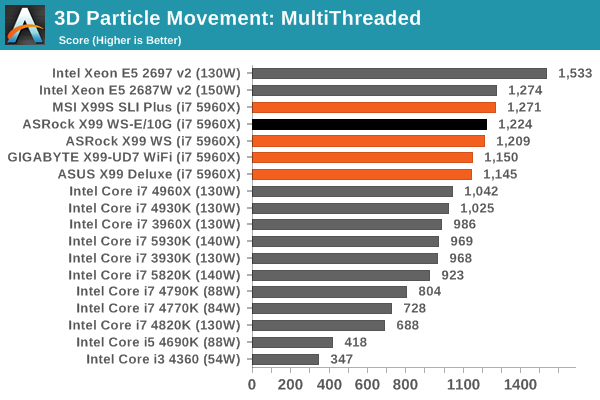
Compression – WinRAR 5.0.1: link
Our WinRAR test from 2013 is updated to the latest version of WinRAR at the start of 2014. We compress a set of 2867 files across 320 folders totaling 1.52 GB in size – 95% of these files are small typical website files, and the rest (90% of the size) are small 30 second 720p videos.
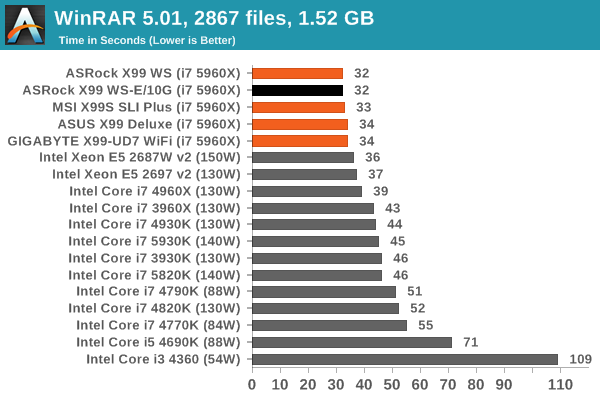
Image Manipulation – FastStone Image Viewer 4.9: link
Similarly to WinRAR, the FastStone test us updated for 2014 to the latest version. FastStone is the program I use to perform quick or bulk actions on images, such as resizing, adjusting for color and cropping. In our test we take a series of 170 images in various sizes and formats and convert them all into 640x480 .gif files, maintaining the aspect ratio. FastStone does not use multithreading for this test, and thus single threaded performance is often the winner.

Video Conversion – Handbrake v0.9.9: link
Handbrake is a media conversion tool that was initially designed to help DVD ISOs and Video CDs into more common video formats. The principle today is still the same, primarily as an output for H.264 + AAC/MP3 audio within an MKV container. In our test we use the same videos as in the Xilisoft test, and results are given in frames per second.
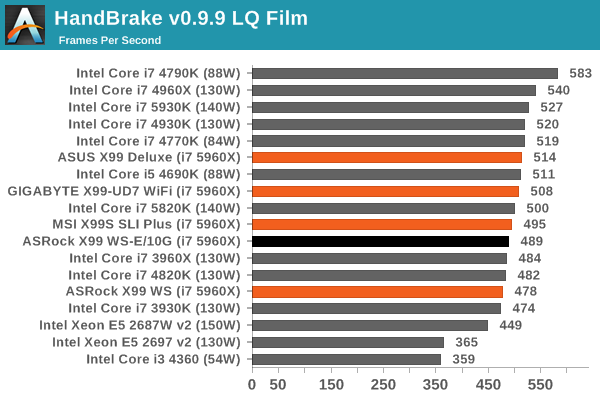
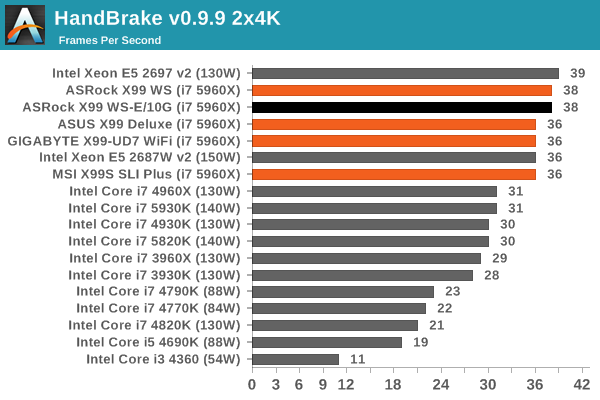
Rendering – PovRay 3.7: link
The Persistence of Vision RayTracer, or PovRay, is a freeware package for as the name suggests, ray tracing. It is a pure renderer, rather than modeling software, but the latest beta version contains a handy benchmark for stressing all processing threads on a platform. We have been using this test in motherboard reviews to test memory stability at various CPU speeds to good effect – if it passes the test, the IMC in the CPU is stable for a given CPU speed. As a CPU test, it runs for approximately 2-3 minutes on high end platforms.
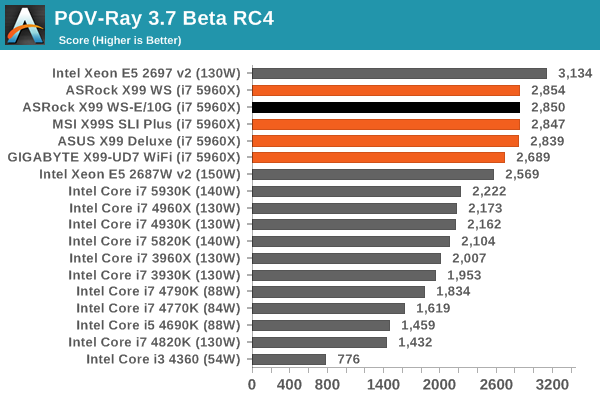
Synthetic – 7-Zip 9.2: link
As an open source compression tool, 7-Zip is a popular tool for making sets of files easier to handle and transfer. The software offers up its own benchmark, to which we report the result.
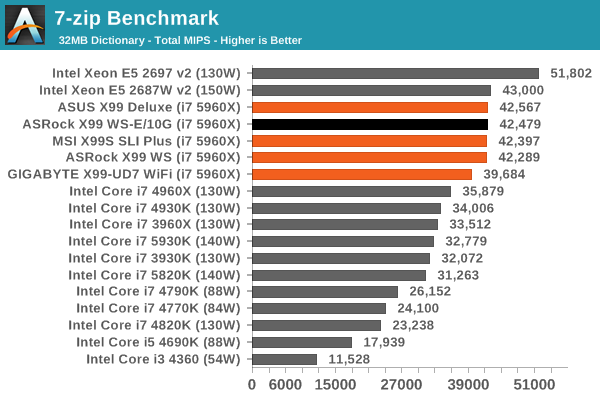










45 Comments
View All Comments
AngelosC - Wednesday, January 7, 2015 - link
They could have tested it on Linux KVM with SR-IOV or just run iperf on Linux between the 2 interfaces.They ruined the test.
eanazag - Monday, December 15, 2014 - link
Okay, so the use case of a board like this is for network attached storage using iSCSI or SMB3. That network storage has to be able to perform above 1GbE bandwith for a single stream. 1 GbE = ~1024 Mbps = ~128 MBps no counting overhead. Any single SSD these days can outperform a 1GbE connection.If you're considering this board, there is a Johan written article on Anand that is a couple of years old about 10GbE performance. It will cover why it is worth it. I did the leg work and found them.
http://www.anandtech.com/show/4014/10g-more-than-a...
http://www.anandtech.com/show/2956/10gbit-ethernet...
extide - Monday, December 15, 2014 - link
At the end of the day, I still think I'd rather the X99 Extreme 11.tuxRoller - Monday, December 15, 2014 - link
How Is the DPC measurement made? Average (which?), worst case, or just once?Ian Cutress - Tuesday, November 1, 2016 - link
Peak (worst value) during our testing period, which is usually a minute at 'idle'TAC-2 - Tuesday, December 16, 2014 - link
Either there's something wrong with your test of the NICs or there is a problem with this board. I've been using 10GBase-T for years now, even with default settings I can push 500-1000 MB/s using intel NICs.AngelosC - Wednesday, January 7, 2015 - link
I recon they were not testing this board's most important feature properly.The reviewer makes it sounds like they don't know how to test…
jamescox - Tuesday, December 16, 2014 - link
This seems more like a marketing thing; who will actually buy this? Given the current technology, it seems like it is much better to buy a discrete card, if you actually need 10GB.The feature I would like to see come down to the consumer market is ECC memory. I have had memory start to get errors after installation. I always run exhaustive memory test when building a system (memtest86 or other hardware specific test). I did not have any stability issues. I only noticed that something was wrong when I found that recently written files were corrupted. Almost everything passes through system memory at some point. Why is it okay for this not to be ECC protected? Given how far system memory is from the cpu (with L3 cache, and soon to be L4 with stacked memory), the speed is actually less important. Everything should be ECC protected.
There may be some argument that the gpu memory doesn't need to be ECC, since if it is just being used for display; errors will only result in display artifacts. I am not sure if this is actually the case anymore though with what gpus are being used for. Can a single bit error in gpu memory cause a system crash? I may have to start running gpu memory test also.
petar_b - Thursday, December 18, 2014 - link
ASROCK solely targets users with need of 10G network. If network card was an discrete option price would be lower and they would target wider audience. I like two PLXes, as I can attach all kind of Network, SAS and GPU cards. PLX and ASROCK quality is the reason I use their mobos.Regarding ECC memory for GPU, not agree there. If GPU is used to do math with OpenCL, then avoiding memory errors is very important.
akula2 - Thursday, December 18, 2014 - link
Avoiding memory errors is beyond extremely important in my case when I churn tons of Science and Engineering things out of those Nvidia Titan Black, Quadro and Tesla cards. AMD did an amazing job with FirePro W9100 cards too.